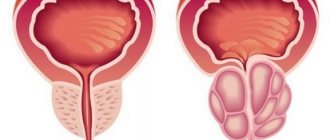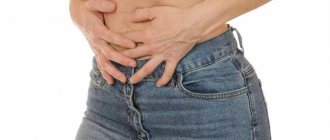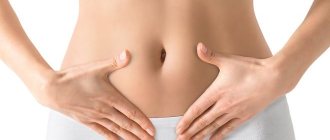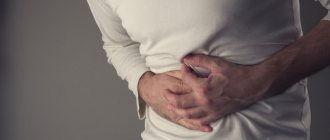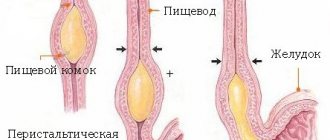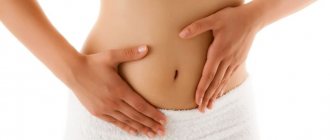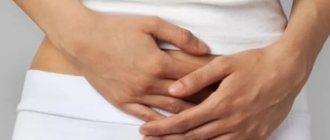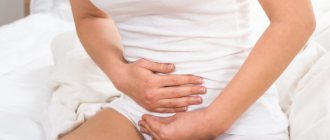If we analyze the complaints of patients turning to doctors about abdominal pathology, we can come to the conclusion that if there is pain in the abdomen in the navel , then most often they indicate the presence of an acute infectious disease.
However, it cannot be said that everything is crystal clear on this issue. In many patients who complain that they have abdominal pain in the navel area, the cause of this symptom is not a pathology of the gastrointestinal tract.
General information
Pain in the navel area is a common symptom and indicates that certain health problems are developing in the body. This condition can be different - it can manifest itself as a sharp acute pain or nagging discomfort. However, even if there is just a little colitis in this place, this symptom cannot be ignored. If you pay attention to this signal from the body in a timely manner, you can prevent serious illnesses.
Soreness on the right
In the lower right part near the navel there are the following internal organs: ureters and appendix, part of the intestine, female organs - fallopian tube, right ovary. The upper right square includes the intestines, pancreas, liver and gallbladder.
If the pain is localized in the right side of the abdomen, the problem lies in one of the following organs:
Appendix
Pregnancy ectopic
Sharp pain in the lower abdomen in women may indicate that the egg has implanted in the fallopian tube and not in the uterus. Also, such pain can accompany ovarian rupture. Both phenomena require urgent medical intervention.
Liver
If there is mild, constant pain in the liver, localized in the depths, it is necessary to be tested for hepatitis.
Why does my stomach hurt in the navel area?
If a child or an adult has a stomach ache in the navel area, this means that there are problems with the functions of the organs located in this area. So, in this area are projected:
- loops of the small intestine;
- part of the duodenum;
- transverse colon;
- upper parts of the kidneys and ureters;
- large oil seal;
- greater curvature of the stomach (if the stomach is prolapsed).
Most often, abdominal pain to the left of the navel at the top or abdominal pain to the right of the navel develops as a result of diseases of the small intestine. If the small intestine is not functioning properly, nutrient absorption is impaired, which can negatively impact your overall health. Therefore, you should not try to determine on your own what is to the right of the navel or what is to the left of the navel. If such pain occurs regularly, you should immediately consult a doctor. It is especially important to consult a doctor if you experience additional symptoms described below, as well as if your stomach hurts in this area during pregnancy , or if a lump has appeared there. Parents should not delay visiting a specialist if their child’s stomach hurts in the navel area and nausea lasts for several days.
Often the causes of pain in the navel area are associated with the following diseases:
- acute and chronic disruption of the blood flow of the mesenteric vessels that supply the jejunum;
- acute obstruction of the lumen of the jejunum ;
- umbilical hernia – pain manifests itself with pinching or stress;
- jeunitis (inflammatory process in the jejunum);
- spastic, infectious, non-spastic enterocolitis ;
- enzyme deficiency , in which parietal digestion in the jejunum is disrupted;
- irritable bowel syndrome , in which pathological changes in jejunal motility are noted;
- jejunal oncology.
If the navel hurts when pressed, we can talk about the development of a number of diseases. When pressing under the navel, pain occurs in the following diseases:
- enteritis;
- gastroenteritis;
- enterocolitis;
- appendicitis;
- abdominal migraine;
- volvulus;
- hernia;
- intestinal diverticulitis.
With each of these diseases, not only pain and discomfort in the abdomen develops, but also other symptoms. That is why it is very important to carefully monitor all changes in the body’s condition and be sure to tell your doctor about all the symptoms that appear.
Pain around the navel due to obstruction of the jejunum
It is important to know what this means - jejunal obstruction . This is a very serious condition that can cause death if not treated promptly.
The intestinal lumen can be blocked by a mechanical obstacle ( roundworm , gallstone, tumor ), as well as as a result of compression from the outside due to adhesions or volvulus. In children and young people, this condition with pain near the navel and slightly above sometimes occurs due to intussusception , that is, the introduction of a loop of intestine into another, neighboring intestine.
With this condition, a person has abdominal pain above the navel or in the peri-umbilical area. Gradually, the pain increases, there is pulsation and a decrease in the interval between when cramping pain appears.
In this condition, not only does the stomach above the navel hurt severely, but nausea and vomiting also develop, after which the condition only improves for a short time. Gradually, the vomit changes to the contents of the intestines, there is no stool, and gases do not pass away. After some time, the pain and burning sensation go away, but the patient’s condition becomes significantly worse. Blood pressure drops sharply tachycardia are noted .
Such symptoms are very life-threatening, and if help is not provided in a timely manner, death is possible. Therefore, if the causes of pain above the navel are associated with obstruction, it is important to understand that this condition is very serious.
Pain near the navel in acute disorders of mesenteric circulation
Sometimes this pathology occurs due to blockage of the mesenteric vessels by particles of blood clots from the bloodstream. This phenomenon is likely if a person suffers from cardiovascular diseases. Insufficient blood supply is also possible with:
- compression of the arteries from the outside due to the development of tumors;
- blockage of mesenteric arteries by blood clots .
In this condition, severe cramping pain develops in the abdomen, in the center near the navel. It becomes a little easier for a person when he takes the knee-elbow position. Cramping cutting pain in the abdomen is very difficult to relieve even with the use of morphine . The patient develops cold and sticky sweat, tachycardia , blood pressure rises, and a feeling of horror appears.
Due to the intestinal reaction to ischemia, loose stools and vomiting appear. 6-12 hours after such symptoms begin to develop, the pain subsides, as the nerve receptors of the intestine die. Blood is detected in the vomit, as well as in the stool. Instead of feces, discharge similar to raspberry jelly may appear. peritonitis develops , which is accompanied by acute spasmodic pain in the entire abdomen, stool retention and gas, and a general deterioration of the condition. With this pathology, urgent hospitalization and surgical intervention are necessary.
Pain near the navel with chronic disorders of mesenteric circulation
If a person progresses nonspecific aortoarteritis and atherosclerosis , then chronic intestinal ischemia . In this condition, pain manifests itself in a special way: from the area near the navel it spreads to the iliac fossa on the right and to the epigastric region. The pain is cramping and begins about half an hour after the person has eaten. After using nitroglycerin, the pain goes away. While the disease progresses, the person loses weight, his intestines function poorly - alternating constipation and diarrhea , bloating, rumbling. Since this disease progresses gradually and the condition worsens, it is very important to undergo diagnosis and subsequent treatment prescribed by a specialist.
Pain due to chronic jejunitis
Chronic jeunitis is a long-term inflammatory process in the jejunum. The causes of inflammation in adults and children are associated with different manifestations: the disease develops after intestinal infections, parasites, alcohol abuse, poor diet, immunodeficiency states, chronic hepatitis , metabolic disorders.
Spastic pain is most pronounced in the umbilical region due to spasm of the intestinal wall. flatulence , caused by stretching of the intestinal mucosa due to the accumulation of gases in it, also appears mesadenitis develops - an inflammatory process in the lymph nodes of the mesentery. In this case, it hurts below the navel, on the right under the navel, and also in the hypochondrium on the left side. As the disease progresses, gangliolitis , and the pain changes from spastic to burning. With this condition, not only does the stomach hurt below the navel, but women and men develop painful diarrhea, which requires visiting the toilet up to 20 times a day. Often, diarrhea develops immediately after a person has eaten, and tremors , a sharp drop in blood pressure, and weakness are also noted.
Pain in women and men with this condition is accompanied by a change in the nature of stool. Initially, it is a mushy mass in which you can see the remains of undigested food. Later, the stool becomes foul-smelling and foamy. If the feces acquire a shine and the consistency of an ointment, there are suspicions that this may be the development of a pronounced pathology. The general condition of the child and adult due to enteric syndrome and vitamin deficiency also worsens. Since the disease progresses slowly, with proper and timely initiation of treatment, irreversible changes in the jejunum can be prevented.
Pain due to enzyme deficiency (enzyme deficiency enteropathies)
Such pathological conditions develop as a consequence of insufficient production of certain enzymes in the body, which can be either a congenital or acquired disorder. Enzymes also be produced in sufficient quantities. But at the same time be biochemically inferior. As a result, parietal intestinal digestion occurs.
With enzyme-deficiency enteropathies, people experience intolerance to certain foods. If such a condition develops in a child, he lags behind both physical and mental development. An adult develops general enteric syndrome . The most common disease is celiac enteropathy (that is, gluten intolerance), and less commonly, disaccharidase-deficiency enteropathy .
In this condition, symptoms develop after the patient has consumed foods that he cannot tolerate. Pain in the navel area in a child and an adult is accompanied by flatulence, as well as watery, light yellow diarrhea with particles of undigested food. To prevent pain at the navel in a child and an adult with this pathology, you should carefully create a menu, excluding all products to which intolerance develops. Enzyme therapy is also practiced.
Pain in jejunal cancer
A rare cancer that predominantly develops in men after 30 years of age. The first sign that jejunal cancer is severe pain, similar to contractions, in the navel area. In this case, belching, nausea, heartburn , diarrhea, and rumbling in the stomach are also noted. Distinctive signs of the oncological process are tarry stool and anemia, which progresses. In this case, it is necessary to urgently begin treatment, which in this case consists of surgery.
Irritable Bowel Syndrome Pain
This is a functional intestinal disease in which flatulence and cramping pain develops. This is a very common condition that often develops as a consequence of the realities of modern life. The causes of pain in the intestines are very often associated with this condition. It develops approximately twice as often in women. Pain in the navel area in women and men is combined with constipation or diarrhea. The stool has a mucous consistency. People suffering from this disease experience a daily cycle: the majority of symptoms develop in the first half of the day. The causes of pain in the abdomen can be associated with food intake - pain and diarrhea develop immediately after breakfast. After defecation, the patient feels better. During the daytime, the patient is bothered by flatulence, heartburn, and belching. After the gases have passed or the person has visited the toilet, the condition improves again.
This disease can cause pain on the right and left in the hypochondrium, in the iliac region on the right. In the evening and at night a person feels good. But in general, the disease creates physical and physiological discomfort, so it is important to carry out the correct treatment and follow all the doctor’s advice.
Pain in the navel area with other diseases
Nonspecific ulcerative colitis
This condition is a polyetiological intestinal disease, which is characterized by the development of foci of necrosis and ulcers on the mucous membrane. A person suffering from this disease develops diarrhea, and blood in an adult’s stool is found quite often. Abdominal pain bothers me. If the condition is complicated by intestinal obstruction or intestinal perforation, the pain intensifies, the temperature rises, and signs of peritoneal irritation are noted. If the course of colitis is uncomplicated, then body temperature does not exceed 38 degrees, false urge to defecate with pain, and bloating are noted. Differential diagnosis involves endoscopy, as well as the use of X-ray methods for examining the intestine.
Crohn's disease
This disease is also called granulomatous enteritis . The disease affects any part of the intestine, most often the ileum ( ileitis ). The disease is inflammatory in nature and manifests itself in people who are genetically predisposed and who have a impaired autoimmune response in the case of concomitant intestinal infections. The course of the disease is characterized by the development of intoxication, in which severe fatigue and lethargy are noted. The patient also has a fever, constant diarrhea, burning and pain in the abdomen. Sometimes such pain is very reminiscent of an attack of appendicitis . In addition, there is bloating, vomiting, loss of appetite, and weight loss. The disease is likely to be complicated by intestinal obstruction, perforation of the intestine, fistulas in the bladder, toxic megalkolone . To determine the correct diagnosis, a specialist performs a biopsy and endoscopy of the intestine.
Mesadenitis
In this condition, an inflammatory process of the mesenteric lymph nodes develops due to a viral or bacterial process occurring in the body. As a rule, it develops as a result of infection of the body with salmonella , staphylococci , klebsiella , enteroviruses , shigella , adenoviruses , mycobacterium tuberculosis , and the Epstein-Barr virus .
With this disease, a person experiences signs of intoxication, as well as abdominal pain. The disease can be diagnosed by performing an ultrasound examination of the abdominal cavity, as well as tomography. In some cases, diagnostic laparoscopy is required.
Features of pain and their localization
Pain in the navel area can indicate a huge number of different problems, so the main thing is to correctly determine the type of pain and start treatment in time. The
umbilical area contains several systems and organs, problems in which pain can occur. Based on the location of the pain and its nature, we can make a preliminary conclusion about the reasons that caused it.
Nature of pain:
- Acute pain. It can occur when an umbilical hernia is strangulated, an intestinal ulcer or gallbladder pathology. If there is acute pain radiating to the lumbar region simultaneously with the urge to urinate, this may be due to the movement of kidney stones.
- Cutting (stabbing) pain. It can manifest itself in acute appendicitis, pathologies of the genitourinary system (in women), cholecystitis, dysfunction of the stomach and intestines.
- It's a dull pain. It can occur with flatulence, intestinal obstruction, the development of tumors, diseases of the genitourinary system, chronic enteritis.
- Nagging pain. It is often observed in pregnant women with stretching of the peritoneal walls, as well as with pathologies of the genitourinary tract and intestinal obstruction.
- Pain when pressed. With an umbilical hernia, pain near the navel is often combined with a feeling of nausea, diarrhea and bloating. In this case, the protrusion of the navel is noticeable upon visual inspection, and a characteristic compaction is felt to the touch, and when pressed on, the pain noticeably intensifies. Also, pain near the navel when pressed, accompanied by nausea, is characteristic of appendicitis, but the pain intensifies on the lower right side.
- Pain after lifting weights. Appears with increased intra-abdominal pressure, umbilical hernia, or stretching of the abdominal wall in women who have given birth.
- Severe pain. Often accompanied by acute conditions: appendicitis, umbilical hernia, volvulus, cancer. A child may experience acute pain in the umbilical region due to a hereditary abdominal hernia. In this case, the pain can be both constant and paroxysmal in nature and accompanied by constipation, flatulence, and nausea. Painful sensations gradually shift to the stomach area, gradually intensifying.
- Pain after eating. The stomach begins to hurt after eating with gastritis, with belching, a feeling of heaviness, and loss of appetite. The same symptoms are typical for indigestion of an infectious nature, for impaired circulation of the mesenteric vessels, as well as for irritable bowel syndrome.
Note! It should be borne in mind that each pathology or disease has its own specific set of symptoms, so it is very important to notice any functional changes in the body so that the diagnosis can be made most accurately.
Why does the stomach hurt in the navel area:
- If it hurts below the navel:
- Crohn's disease;
- Enteritis;
- Diseases of the large intestine;
- Nonspecific ulcerative colitis;
- Mesadenitis;
- Endometriosis;
- Diverticulitis of the small intestine;
- Pathologies of the genitourinary system.
- If it hurts to the left of the navel:
- Accumulations of gases in the large intestine;
- Diseases of the pancreas, spleen.
- If it hurts to the right of the navel:
- Volvulus of the small intestine;
- Appendicitis.
- If there is pain around the navel:
- Umbilical hernia;
- Acute appendicitis.
- If it hurts above the navel:
- Gastropathy;
- Ulcer of the stomach and duodenum.
Almost all pain associated with pathologies of the peritoneal organs is initially localized near the navel. Therefore, you should monitor the specifics of pain in order to narrow down the search for a possible illness. To do this, you need to determine the nature of the pain (cutting, sharp, stabbing, etc.), as well as what preceded the onset of pain (food, exercise) and what other symptoms were additionally observed (fever, vomiting, nausea, diarrhea).
Causes of pain above the navel
To determine the cause of such manifestations, you should know what is located above the navel and, accordingly, what can hurt.
In the area above the navel is part of the duodenum and the pyloric part of the stomach. Therefore, pain develops if ulcerative processes begin to occur in these organs. Gastropathy also causes pain in this area .
At first, there is a slight burning sensation and discomfort, after which, if the ulcerative process progresses, the pain intensifies and worries constantly. Perforation of the ulcer causes sharp and unbearable pain, and general symptoms also increase, leading to loss of consciousness.
Constant pain above the navel with cancer of the stomach and duodenum .
Attacks above the navel
The digestive organs contain many nerve endings, so they quickly respond to harmful influences. If there is severe pain in the abdomen above the navel, you need to check those organs that are located in this area. The stomach may hurt for the following reasons:
Oncology
The clinical picture of the disease is similar to that that accompanies a banal inflammation of the gastric mucosa (gastritis). However, over time, the following pronounced symptoms are observed: weight loss, apathy and weakness, lack of appetite, nausea, etc.
Stomach
The most common cause is gastritis, which occurs in an acute form. The inflammatory process is manifested by pronounced pain that has a high level of intensity, and sometimes spasms occur in this area of the abdomen. If acute pain predominates, it is accompanied by vomiting, pale skin, and dry mouth. In addition, the cause of pain can be an ulcer of the duodenum and stomach. Soreness occurs in the morning, as well as on an empty stomach. More information about diseases that manifest themselves can be found in the article on the topic.
Pancreas
When the localization is concentrated directly above the navel, this may indicate damage to the central part of this organ.
Causes of pain below the navel
It is important to clearly know what is below the navel in women and what to do if the stomach hurts below the navel in women and men. If pain in the navel develops in women and pain sensations below, this may indicate diseases of the female genital organs. Most often, such symptoms indicate the development of endometriosis , a common pathology of the female genital area. In addition, such sensations may be evidence of the development of colon pathologies. In particular, pain in this area can cause an ischemic condition of the intestine. In the chronic course of the disease, it hurts and aches constantly; in the acute course, there are sharp manifestations and paralysis of intestinal peristalsis. Spastic aching pain and atonic constipation are signs characteristic of atherosclerosis of the vessels that feed the intestines.
In addition, pain directly in this area can cause the following diseases:
- irritable bowel syndrome;
- cancer of the uterus, ovaries;
- cystitis;
- uterine fibroid;
- abdominal aortic aneurysm.
On right
The right kidney, part of the large intestine, and appendix are located in this area. The following serious diseases can cause pain in their projection:
- acute appendicitis;
- gastroduodenitis;
- inflammatory process in the colon;
- pyelonephritis;
- prolapse of the kidneys.
Left
The main cause of pain in the navel area on the left is diseases of the small intestine. Also in this projection are the ureter, intestinal loops and omentum. A general list of causes of pain to the left of the navel includes:
- gastroduodenitis;
- inflammatory processes in the lungs;
- sigmoiditis;
- ischemic or ulcerative colitis;
- inflammation of the mesenteric lymph nodes;
- bowel cancer;
- inflammation of the ovary;
- endometriosis;
- uterine fibroid;
- ectopic pregnancy;
- left-sided ovarian cyst.
Below the navel
Localization of pain below the navel is associated with intestinal diseases. A common cause is inflammation of the small intestine. Other factors that provoke the appearance of this symptom:
- irritable bowel syndrome;
- jeunitis;
- lack of jejunal patency;
- umbilical hernia;
- circulatory disorders of the mesenteric vessels;
- enzyme deficiency;
- diverticulosis of the sigmoid colon;
- gastrointestinal cancers;
- acute pyelonephritis;
- cystitis;
- period of menstruation.
Stomach pain and fever
An increase in temperature indicates the development of an inflammatory process in the body. Against the background of pain in the navel area, this symptom may indicate the following diseases:
- pancreatitis;
- inflammation of the appendages;
- follicle rupture;
- cholecystitis;
- peritonitis;
- stomach ulcer;
- problems with the ovaries.
When you press
The appearance of pain in the navel when pressing on it is associated with diseases of the rectum or genitourinary system of a woman. If such actions intensify the pain syndrome, then the cause may be:
- omphalitis;
- appendicitis;
- volvulus of the small intestine;
- diverticulosis;
- intestinal ulcer;
- abdominal migraine;
- umbilical hernia;
- adhesions in the peritoneum;
- thrombosis of mesenteric vessels;
- flatulence;
- aortic aneurysm.
Acute pain
Too sharp or sharp pain in the navel area in women appears due to more serious pathologies, such as volvulus, appendicitis or intestinal obstruction. The pain syndrome can be cramping or constant. Possible causes of the symptom:
- atherosclerosis of the vessels feeding the intestines;
- exacerbation of chronic enteritis or gastroenteritis;
- deformation of the mucous membrane under the abdominal cavity;
- irritable bowel syndrome;
- cystitis;
- intussusception;
- umbilical hernia;
- oncological diseases;
- inflammation of the sigmoid colon;
- attacks of appendicitis;
- intestinal dyskinesia;
- cholelithiasis;
- worms;
- cyst breakthrough;
- Crohn's disease.
After meal
The occurrence of pain after eating in most cases is caused by pathologies of the digestive tract. The main factors provoking this symptom are:
- diaphragmatic hernia;
- irritable bowel syndrome;
- dysbacteriosis;
- gastroduodenitis;
- gallbladder pathology;
- gastric obstruction;
- gallbladder pathology;
- pancreatitis;
- peptic ulcer;
- gastritis;
- esophageal stenosis;
- intolerance to certain foods.
During pregnancy
The main cause of pain in the navel area when carrying a child is the rapid growth of the fetus in the second half of pregnancy. As a woman's skin begins to stretch, this leads to discomfort. In this case, tension pain develops, which is not considered dangerous. Other physiological causes of this symptom in pregnant women:
- hormonal changes in the early stages;
- decreased intestinal motility in the second trimester;
- active movements of the child;
- polyhydramnios pregnancy;
- greatly gained weight.
Before childbirth, the navel may protrude outward, which also causes discomfort. Among the dangerous causes of pain in the center of the abdomen during pregnancy are:
- cystitis;
- umbilical hernia;
- intestinal infection;
- stomach pathologies;
- poisoning;
- placental abruption or damage to its blood vessels;
- pyelonephritis;
- acute appendicitis.
Pain to the left of the navel
If pain develops in the left side at the level of the navel, you need to determine which organ is located on the lower left. On the left are the omentum, intestinal loops, ureter, and renal hilum.
Pain in this area may be due to gas accumulation. If a pathological process of the large intestine develops, then in addition to pain, stool disturbances, the appearance of mucus and blood in the stool, and an increase in temperature will be noted.
If scarlet blood appears in the stool. This means that a patient with hemorrhoids , if the stool becomes tarry, this means that bleeding is developing in the gastrointestinal tract.
Pain in the umbilical area due to irritation of the diaphragm is also possible with viral lung diseases.
Classification of periumbilical pain
Unpleasant sensations in the navel area are not unambiguous; they can have varying intensities.
So, before making a diagnosis, specialists pay attention to the following points:
- on which side of the navel does a person feel discomfort (left, right, above, below, in the umbilical node itself);
- does it radiate to other segments of the abdomen;
- pain is constant or intermittent;
- when discomfort occurs - when moving or lying down, sitting, standing;
- what kind of pain is felt - sharp, dull, pulling, cutting, stabbing, accompanied by spasms.
Why does the belly button hurt during pregnancy?
Often, expectant mothers develop pain in the navel area during pregnancy . The reasons for this phenomenon may be different. First of all, why the navel hurts inside may be due to the fact that the stomach grows every day, and the skin on it becomes tense. Also, the cause of such manifestations may be weakness of the abdominal muscles. Sometimes during pregnancy, women's navel even turns outward, but after the baby is born, everything returns to the way it was before. Sometimes a woman's navel pulls from the inside. What is this, it is better to ask your doctor. Indeed, sometimes this condition indicates the development of an umbilical hernia. If severe pain develops, accompanied by nausea, vomiting, gas formation and other unpleasant symptoms, you need to call an ambulance.
Also, pregnant women may develop intestinal infections, which requires consultation with a doctor. The fact is that with loose stools and vomiting, intestinal tone increases, which can also affect the tone of the uterus . And this is unsafe during the period of bearing a baby. In addition, there is a risk of developing appendicitis, which is also very dangerous for the expectant mother.
After the symptoms have been eliminated, a specialist must monitor the condition of the fetus.
Methods for diagnosing the cause of pain
If pain appears around the navel, you should consult a therapist or gastroenterologist. A woman may also need to consult a gynecologist. A general practitioner can refer you to him, just like to a surgeon. It all starts with an external examination of the patient. The doctor clarifies the woman’s complaints and notes specific signs that may indicate certain diseases.
The specialist pays attention to the skin color, general condition of the patient, and the presence of pathological changes. In addition to visual inspection, the following studies are prescribed:
- diagnostic laparoscopy;
- X-ray;
- Ultrasound of the abdominal cavity;
- fibroesophagogastroduodenoscopy;
- computed and magnetic resonance imaging;
- angiography;
- virological, bacteriological and parasitological studies;
- biopsy;
- research on tumor markers;
- endoscopy.
When figuring out why the stomach hurts in the navel area, doctors pay great attention to the patient’s sensations. Despite the severity of the situation, it is very important to obtain detailed information about the characteristics of pain symptoms:
- time of onset of the pain syndrome, features of its development (suddenly or progressively);
- nature of the pain (sharp, nagging, spasmodic);
- how long does an individual spasm last and with what frequency;
- what actions are associated with the phenomenon (load, food intake, nervous stress);
- in what direction is it localized (degree of displacement from the navel, presence of radiating pain);
- reaction to painkillers.
So, if your stomach hurts directly in the navel area and below, Crohn's disease, enteritis, colitis, and diseases of the genitourinary system are suspected; above the navel – diseases of the epigastrium and the stomach itself are added. If the pain moves to the right - appendicitis.
On a note! There is a possibility of so-called somatic pain, when the peritoneal organs are not damaged, and sensitivity is associated with irritation of the spinal nerves.
After collecting anamnesis, additional studies are carried out using laboratory and instrumental methods:
- blood and stool test (general, biochemical);
- genetic research;
- Ultrasound of the abdominal organs;
- magnetic resonance imaging (MRI);
- irrigography (intestinal x-ray with contrast);
- colonoscopy.
When pain appears in the lower abdomen, women undergo a comprehensive examination (taking into account the variety of possible causes of discomfort). In addition to examining and interviewing the patient, diagnostics includes:
- Laboratory testing of blood (clinical, biochemical, to determine blood group), urine, feces (for latent infection or helminthiasis).
- Ultrasound, MRI (or CT) of the abdominal organs (with an emphasis on the condition of the intestines), pelvis, kidneys. The methods allow you to quickly and with maximum accuracy identify inflammation, blood clots, stones, tumors, erosions, and violations of the anatomy of organs.
- Bacteriological examination of urine (culture). Allows you to identify the causative agent of the infectious-inflammatory process.
- ECG, fluorography.
- Colonoscopy (examination of the condition of the large intestine).
- Dopplerography (to assess the state of blood supply to the fetus inside the uterine cavity).
- Cystoscopy (method of instrumental examination of the bladder).
- Laparoscopy. Several punctures are performed in the abdominal or pelvic area. An instrument equipped with a microscopic camera is placed in them and the condition of the organs is examined.
- Survey X-ray examination.
- In case of tumor processes, a biopsy is performed followed by histological analysis.
Additional types of research depend on the specific clinical case and are prescribed individually.
conclusions
Thus, you can answer the question, if there is pain around the navel, what it could be, in different ways. If your stomach hurts near the navel, this signals a lot of diseases. Since some of these diseases are life-threatening, severe abdominal pain in the navel area is a good reason to see a doctor. It is important to immediately consult with a specialist and tell him in detail about all the symptoms - does it hurt near the navel on the right or left, what exactly is the nature of the pain, how long the pain around it lasts. It is especially important to consult a doctor immediately if there is severe pain around the baby’s navel or such pain occurs in women during pregnancy.
If you diagnose the disease in a timely manner and determine the causes of pain to the left of the navel or the causes of pain to the right of the navel, then the patient’s chances of recovery are significantly increased. It is important to strictly follow the doctor's recommendations on what to do and how to carry out treatment.
Which doctor should I contact?
With an “acute abdomen” it is recommended to go directly to an ambulance, since such a pathology requires immediate surgery. If the pain is tolerable, then you should make an appointment with a gastroenterologist or surgeon, but if you are not sure of the approximate diagnosis, then you can contact a therapist so that he can write out a referral to a specific doctor.
When your stomach hurts, you don’t want to enjoy life. Soreness in the navel area is a sign of many ailments of the digestive or genitourinary system, which should be treated without fail, and not postponed until a critical moment occurs.
Otherwise, complications and even death may occur. So you shouldn’t hesitate to go to the doctor, but you need to take care of your health constantly.
Video
Any painful sensation causes discomfort and makes you feel worse. If your stomach hurts in the navel area, you should not take medications right away. First you need to find out the cause of the pain. It is forbidden to ignore such signals from the body; they can indicate a serious illness occurring in the human body. It is necessary to immediately deal with possible provoking factors of such a pathology.
Abdominal pain in the navel area can be the result of a huge number of diseases. This is due to the fact that the abdominal cavity contains many different organs responsible for specific functions. In simple words, any problem that occurs in a specific organ can provoke pain in the navel area.
Abdominal pain in the navel area is true when it is related to the organs adjacent to this territory, as well as irradiating - the source is located in another place, but radiates to the umbilical region.
Pain in the navel area can be caused by the following pathologies:
- Crohn's disease and gastritis, as well as ulcerative diseases of the duodenum and stomach;
- hepatitis, volvulus;
- pathology of the pancreas, intestinal obstruction;
- hernia, as well as its pinching;
- inflammatory process in the intestinal diverticulum;
- gynecological pathology – ectopic pregnancy, presence of a cyst in the ovary;
- irritable bowel, urinary tract blockage.
Determining the cause of pain is an integral step in prescribing the correct treatment.
General preventive actions
Preventive measures to prevent pain in the navel area include the following:
- Preventive examinations of the gastrointestinal tract at least once a year.
- Timely detection and treatment of diseases of the abdominal organs.
- The use of rational nutrition.
- Rejection of bad habits.
- Balance of the psycho-emotional sphere.
- Maintaining an active lifestyle.
Painful sensations near the navel can be caused by various pathologies, some of which are life-threatening.
Determining the source of pain is often a difficult task due to vague symptoms, when even the patient himself is not able to accurately describe the nature of the pain.
The appearance of any pain in the navel area is a reason to seek medical help, since only an experienced specialist in a clinical setting can make a correct diagnosis and prescribe effective treatment.
Pain around the navel in women
Often in women, this symptom indicates the development of diseases of the reproductive system. In this case, pain in the navel area is localized in the groin area.
In women, when examined by specialists, the following causes of the painful condition are identified:
- diseases of the ovaries (congenital pathologies, polycystic diseases, inflammation, cancer) – there is aching periodic pain that develops into a constant and increasing intensity;
- dysmenorrhea (painful menstruation) - pulls in the lower abdomen and in the navel area;
- diseases of the uterus (fibroma, cancer, endometriosis) – dull pain can be seen at the initial stage of the disease, which develops into a nagging pain;
- inflammation of the appendages (obstruction of the fallopian tubes, salpingoophoritis), indicated by cutting pain.
Acute pain in the inguinal segment of the abdomen can occur in women with the development of cystitis, candidiasis, and STDs.
Periumbilical pain is a dangerous symptom during pregnancy. It may indicate the development of the fertilized egg not in the uterine cavity, but in the fallopian tube. Pain begins to appear from the moment it attaches to the wall of the pipe, increasing its intensity as it increases in size.
When there is a threat of miscarriage, a woman feels strong pulling sensations in the lower abdomen and lower back, which may be accompanied by cramps and uterine bleeding.
In a pregnant woman, as the fetus grows, the abdominal muscles stretch, which can also cause unpleasant pulling and aching pain in the upper umbilical segments.
Pain around the navel in children
The child's complaints of pain in the umbilical area cannot be ignored. Often the child cannot clearly explain where and how it hurts.
Therefore, parents should pay attention to the following points:
- if the child is lying down and it hurts to turn around, he feels acute pain, doctors call this diagnosis “acute abdomen”, it indicates the possible occurrence of peritonitis or acute appendicitis, in which emergency surgical care is necessary;
- if a child complains of discomfort in the epigastric region (above the navel), and belching and vomiting are observed, then most likely it is gastritis;
- when children complain of pain in the peri-umbilical region of the abdomen, along with such signs as swelling under the eyes, instability of body temperature, and rare urination, specialists often diagnose nephritis;
- if a child suffers from constipation and, regardless of bowel movements, abdominal pain does not go away, this may indicate gastroduodenitis;
- abdominal pain may be accompanied by acute acute respiratory viral infections;
- if pain in the navel area makes itself felt immediately after eating, the child feels nauseous and feels a bitter taste in the mouth, there is a high probability that the doctor will diagnose an intestinal ulcer;
- if a child cannot straighten his back in a sitting position, then he feels spasmodic or cutting pain in the abdomen, which is inherent in ulcerative colitis;
- if pain in the navel in a child is accompanied by thirst, lack of appetite, weakness, and stool instability, it is advisable to assume a gallbladder disease;
- pain in the upper abdomen along with yellowing of the skin, vomiting, diarrhea indicates the manifestation of acute pancreatitis;
- if abdominal pain appears as a result of stress, anxiety, reluctance to complete a task, and is accompanied by nausea and vomiting, this may be a sign of abdominal migraine;
- pain in the umbilical area in a child may indicate lactose intolerance, which causes stool disturbances (liquid and foamy), intestinal upset after consuming dairy products:
- Another diagnosis, which is evidenced by discomfort in the peri-umbilical region of the abdomen in a child, is food allergy; ingestion of allergens irritates the intestinal walls, which leads to cramps and diarrhea;
- The absence of bowel movements in a child against the background of pain in the navel area can be the cause of intestinal obstruction due to intestinal volvulus.
Abdominal pain in a child is often accompanied by fever, nausea and vomiting. Even a doctor sometimes finds it difficult to make a correct diagnosis of a small patient. Therefore, for any intensity of pain in the abdomen, you should seek qualified help from specialized medical institutions.
Painful periumbilical segments
The doctor can specify the patient’s diagnosis depending on the location of the pain:
- If the right hypochondrium region hurts from the navel, the liver or gall bladder is suffering.
- If the pain is noticeable in the epigastric region (above the navel), there may be problems with the stomach - gastritis, ulcers, cancer, diseases of the duodenum.
- Pain in the left hypochondrium from the navel - a malfunction of the pancreas, lung disease.
- Unpleasant sensations in the right lateral area from the navel, spasms near the navel - there are malfunctions in the intestines.
- Colitis near the navel - possible obstruction and inflammation of the intestines, hernias, flatulence.
- Aching pain near the navel – abdominal migraine, helminthic infestations.
- If the left lateral area from the navel hurts, kidney disease is diagnosed.
- Sharp pain makes itself felt in the right iliac region - a sign of appendicitis.
- Acute pain in the suprapubic region (below the navel) - diseases of the genitourinary system, peritonitis, diseases of the colon (diverticulosis), pyelonephritis make themselves felt.
- Unpleasant sensations in the left iliac region - the kidneys suffer, irritable bowel syndrome is observed.
Causes of abdominal pain below the navel in men
Any cramping pain that develops in the lower abdomen in men almost always indicates a disturbance in the gastrointestinal tract. The most common causes are: Crohn's disease, the presence of adhesions, ulcerative colitis, tumors of malignant origin. It is worth noting that all of the listed gastrointestinal pathologies can be diagnosed in women.
Crohn's disease
The disease occurs in a chronic format. Any part of the gastrointestinal tract can be involved in the pathological process, but most often the large intestine and the final section of the small intestine are affected. The exact reasons why Crohn's disease develops. It is generally accepted that viruses and bacteria become provoking factors. Transmission of the disease gene by inheritance cannot be ruled out.
Crohn's disease can be diagnosed in patients of all ages: teenage girls, girls and boys, and adults. But the pathology is especially common in men aged 40 years. Symptoms of Crohn's disease include: sharp pain in the abdomen below the navel, weight loss due to diarrhea, and fever.
Treatment of pathology comes down to the elimination and alleviation of pathological symptoms. The patient is prescribed corticosteroids, anti-inflammatory and painkillers. Without treatment, a man may experience:
- internal bleeding;
- gastrointestinal obstruction;
- perforation of the intestinal wall.
In this case, the patient is prescribed urgent surgery.
Adhesive disease
Abdominal pain below the navel in men can develop due to adhesions formed in the abdominal cavity. The functioning of the intestines is disrupted, which can result in unpleasant sensations, even painful ones. It is customary to distinguish two types of adhesive pathology: with severe pain in the lower abdomen, with the periodic development of intestinal obstruction.
The following symptoms may indicate the presence of adhesions:
- soreness below the navel;
- problems with passing gases;
- bloating;
- nausea, periodically ending with vomiting.
Nonspecific ulcerative colitis
If a man has pain in the lower abdomen, the cause may be ulcerative colitis. The disease is diagnosed in men 2 times more often than in women.
Typical signs of the development of ulcerative colitis are:
- frequent diarrhea;
- anal bleeding;
- dull pain felt below the umbilical area;
- discharge of pus from the anus during bowel movements.
Treatment of pain in the umbilical area
In each specific case, doctors have to study the medical history of the admitted patient and prescribe individual drug treatment. In case of acute manifestation of pain syndromes, specialists often resort to operating on patients.
Before treatment is prescribed, the patient is sent for tests (blood, urine, feces for occult blood, bilirubin, liver and pancreatic enzymes), ultrasound, CT, MRI, and electrocardiogram.
How to get rid of navel pain, what pills to take to relieve and reduce abdominal pain
If drug treatment is necessary, a specialist may prescribe the following medications:
No-spa for abdominal pain is intended to relieve spasms of the smooth muscles of the digestive organs. It makes the patient feel better during constipation, stomach ulcers, bile duct dyskinesia, urolithiasis and other diseases. No-shpu should not be taken in childhood, during lactation, in case of liver or kidney failure or individual intolerance to the components of the drug. The price of the drug varies between 50-250 rubles.
Spasmalgon for the treatment of pain near the navel is a combined analgesic with a pronounced antispasmodic effect. Designed to relieve pain during intestinal or renal colic, menstrual bleeding and bile duct dyskinesia. Among the contraindications to taking Spazmalgon are: hypersensitivity to its components, intestinal obstruction, disorders of the liver, kidneys and hematopoietic system.
The cost of the drug depends on the manufacturer and ranges from 120-350 rubles. What else can you drink if there is severe pain on the left or right side of the navel? Papaverine for relieving abdominal pain is an antispasmodic used for functional disorders of the digestive tract. Quite often used in the complex treatment of cholecystitis, colitis, renal colic or endarteritis. It is forbidden to use this drug in case of individual sensitivity, low blood pressure, breathing problems and glaucoma. The price ranges from 10 to 90 rubles.
Phosphalugel for the treatment of pain in the center of the abdomen is a balanced gel intended for the treatment of stomach and intestinal ulcers, gastritis, functional diarrhea, intestinal infections and other gastrointestinal pathologies. The use of Phosphalugel is not recommended for patients with diabetes mellitus and renal failure, as well as for pregnant and lactating women. The price varies between 180-370 rubles.
Smecta for abdominal pain is a drug from the group of sorbents used in the complex treatment of acute and chronic diarrhea and functional digestive disorders. Smecta is contraindicated in case of hypersensitivity to the components of the drug, intestinal obstruction, glucose intolerance and before reaching the age of one month. The cost of the drug ranges from 150-360 rubles.
Espumisan for the treatment of abdominal pain is a drug intended to reduce flatulence by changing the tension of gas bubbles in the gastrointestinal tract. In addition, Espumisan is often used before diagnostic studies of the digestive system. Contraindications to the use of this drug are intestinal obstruction and hypersensitivity to its components. The price for Espumisan is 270-460 rubles.
Traditional methods for treating abdominal pain at home, what can be used?
In consultation with the doctor, the treatment of diseases that provoke pain in the navel area can be supplemented with traditional methods. The following medicinal plants will help eliminate unpleasant symptoms:
1 Rowan berries. Used as an anesthetic. To prepare the medicine, the berries should be thoroughly washed, covered with sugar, covered with a lid and left for five hours until they release juice. After this, the container with the medicine must be placed on low heat and cooked for half an hour. They should be taken half a glass three times a day.
2 Horsetail, chamomile and calendula flowers, rose petals, burdock roots, wormwood, dill, rose hips, St. John's wort, plantain and yarrow. The dried raw materials must be combined, thoroughly crushed, poured with a glass of boiling water and cooked for a quarter of an hour. After cooling, the broth should be filtered through several layers of gauze and taken two to three tablespoons three times a day.
3 Decoction of gooseberries. Has a pronounced analgesic effect. To prepare it, it is recommended to mash a tablespoon of berries, add hot water and simmer over low heat for 10 minutes. You should drink this medicine 200 ml three times a day.
4 Flax seeds, chamomile and yarrow flowers. Used as an anti-inflammatory agent. To prepare the infusion, pour three tablespoons of the raw material into a glass of boiling water, cover with a lid, wrap in a warm cloth and leave until completely cooled. Take the medicine half a glass every couple of hours.
5 Blueberries, dried or fresh. Used in the form of a decoction that has an antispasmodic effect. To prepare a decoction, pour 50 grams of blueberries into a liter of boiling water and simmer for a little over low heat. The resulting volume of the drug should be drunk during the day.
The appearance of abdominal pain is a reason to review your diet. The patient is advised to limit the consumption of smoked and canned foods, as well as marinades. If strict adherence to these recommendations does not reduce pain and other unpleasant symptoms, you should consult a specialist.

